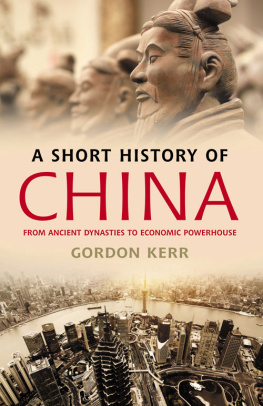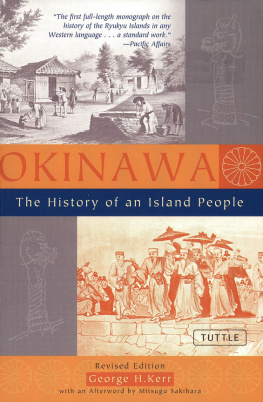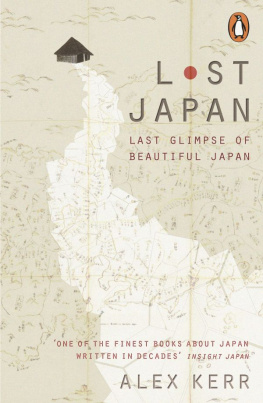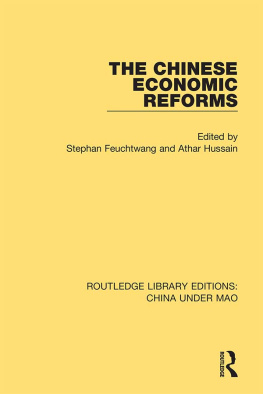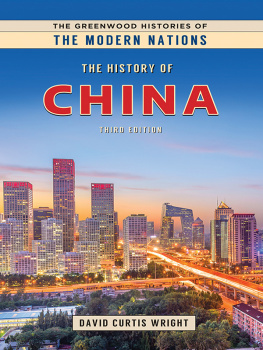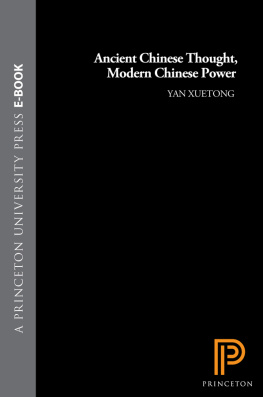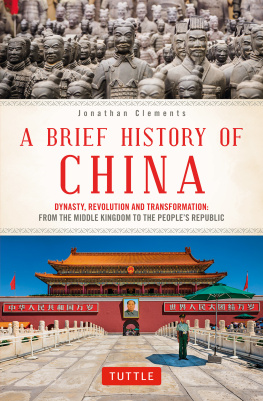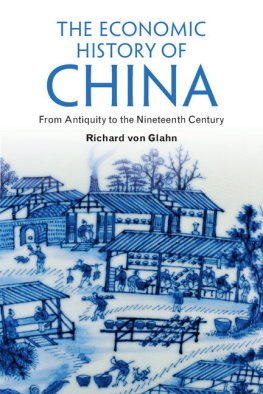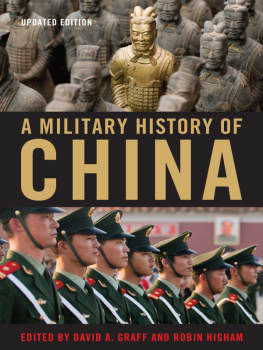The turbulent and chequered past of the worlds most populous country is one of the most fascinating in world history, and relatively little known in the west. From the beginnings of Chinese prehistory right through to internet censorship with the Great Firewall of China, Gordon Kerr offers a comprehensive introduction to the sprawling history of this enormous country.
A Short History of China provides an absorbing introduction to more than 4,000 years of Chinese history, telling the stories of the tyrants, despots, femmes fatales, artists, warriors and philosophers who have shaped this fascinating and complex nation. It describes the amazing technological advances that her scientists and inventors made many hundreds of years before similar discoveries in Europe. It also investigates the Chinese view of the world and examines the movements, aspirations and philosophies that moulded it and, in so doing, created the Chinese nation.
Finally, the book examines the dramatic changes of the last few decades and the emergence of China as an economic and industrial 21st century superpower, making Napoleon Bonapartes words about her ring true: Let China sleep, for when she awakes, she will shake the world.

Gordon Kerr worked in bookselling and publishing before becoming a full-time writer. He is the author of many titles including A Short History of Europe and A Short History of Africa (both published by Pocket Essentials). He divides his time between Hampshire and Southwest France.

POCKET ESSENTIALS
For my brother, Bill Kerr
Acknowledgements
My thanks go to Ion Mills and his team at Pocket Essentials for giving me the opportunity to work on this series of short histories, one of the most rewarding projects on which I have ever had the privilege to work. Thanks also to my indomitable editor, Nick Rennison, one of the nicest men in the world of books. Above all, though, I would like to thank my wife, Diane, who provides such generous and ungrudging support for all that I do.
Contents
Chapter One:
Chapter Two:
Chapter Three:
Chapter Four:
Chapter Five:
Chapter Six:
Chapter Seven:
Epilogue:
Introduction
China, with four millennia of continuous history, is one of the worlds oldest civilisations as well as one of the best documented. Its history was being written as early as the Shang Dynasty (c. 17001046 BC) and in the two great historical works, the Records of the Grand Historian and the Bamboo Annals, a dynasty the Xia that existed even before the Shang is also recorded. Its political system is handily broken up into hereditary monarchies known as dynasties that prevailed until the fall of the Qing Dynasty in 1911 and the first stirrings of a Republic of China.
Until that date, there were 557 emperors. Some were enlightened, cultured and humane men, but others have gone down in history as ruthless, cruel and dissolute. They were also often incompetent, a disaster for a nation that was dependent on the ability of the emperor to raise taxes fairly and efficiently as well as to exercise control over the bureaucratic elite that was a thorn in the side for so many occupants of the Dragon Throne.
China has often been blighted by the influence and ambition of foreigners, whether the marauding hordes from the steppe beyond the Great Wall to the north or the avaricious nations Germany, Britain, France and Japan of recent centuries, hungrily aspiring to carve China up between them. The elements, too, have played their part flood and famine were for many centuries a part of the natural cycle in China, despite the efforts of many clever men to control the floodwaters and to dam the great rivers.
Nonetheless, Chinese culture has always managed to survive, even through the darkest times. One can only wonder at the way that Han Dynasty scholars reconstructed the Confucian classics from memory after they had been destroyed by the previous Qin Dynasty many decades previously. The culture survived in this doggedly stubborn way partly because of the extraordinary conviction of the Chinese people that their land is the centre of everything the Middle Kingdom, or All Under Heaven, as they describe it. Even when engaged in desperate decades-long warfare, they remained united by the fact that they were Han Chinese and they always strove to re-unite, to make their empire whole again.
For many centuries, the sophistication of the culture, science and technology of China left the West lagging far behind, the inventions and advances simply staggering and well in advance of similar innovations in the West. To the Chinese can be attributed the invention of the compass, gunpowder and several centuries before Johannes Gutenberg both woodblock and movable type in printing. Papermaking was first developed in China, leading to the first government-issued paper money during the Song Dynasty (9601279). In the fifth century BC, the Chinese were using advanced metallurgic technology, including the blast furnace and the cupola furnace. They invented the escapement mechanism in water-powered clockworks in the eighth century and the endless power-transmitting chain drive in the eleventh century. The list is endless with advances in music theory, mathematics and astronomy thrown in for good measure.
In the background, however, was the constant cut and thrust of Chinas extraordinary dynastic history, centuries of peace followed by centuries of unimaginable turmoil, emperors murdered by their sons, or imperial hopefuls dispatched by ambitious dowager empresses. The death tolls were often staggering, demonstrating not only a disdain for human life but also the vast and inexhaustible supply of manpower that has always characterised China.
Ultimately, one cannot fail to be impressed and excited by a history at once strange and thrilling, to be appalled and captivated by the powerful men and women who sought control of the Middle Kingdom or who worked to make it a better place. As the new China emerges as a global superpower at the start of the twenty-first century, it is an appropriate moment to discover the fascinating history that has brought it to this point and to bear in mind the prescient words of Napoleon Bonaparte: Let China sleep, for when she awakes, she will shake the world.
Note: This book uses the pinyin system, adopted as the international standard in 1982, for proper nouns. Where deemed necessary for clarification, place names are accompanied by their modern equivalents.
1. Geography of the Middle Kingdom
China is the third largest country in the world, measuring more than 5,200 kilometres from east to west and more than 5,500 kilometres from north to south. This huge expanse of land is stitched together by mountain ranges that form barriers between habitable river valleys. Dominating this land mass are two great river systems the Yellow River to the north and the Yangtze River in the centre.
The Yellow River rises in the Bayan Har Mountains in Qinghai Province in western China and flows through nine Chinese provinces. It traverses the northern deserts before flowing south through a hilly area of fertile soil perfectly suited to cultivation. At the end of these highlands, the river turns to the east, now yellow from the silt it carries, its banks wide apart, and crosses the alluvial plain before emptying into the Bohai Sea. Often called the cradle of Chinese civilisation, it cuts across the Wei valley to the west of Beijing, an area considered the birthplace of ancient Chinese cultures and a region of great prosperity in early Chinese history. The Yangtze, Asias longest river, carries a greater volume of water than the Yellow River. It rises in the glaciers of the Qinghai-Tibet Plateau, flows eastwards across southwest, central and eastern China and into the East China Sea at Shanghai. Its river basin is home to around a third of the population of the Peoples Republic of China.
Next page
